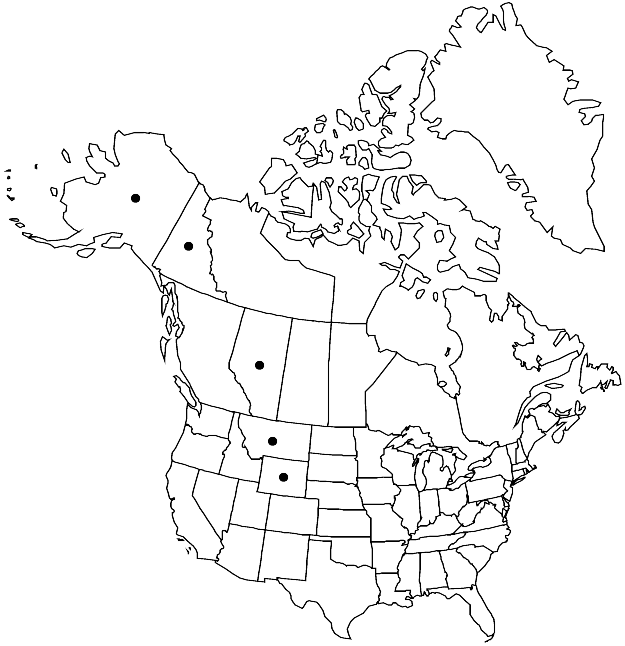Difference between revisions of "Draba porsildii"
Canad. J. Bot. 52: 1795, fig. 8. 1974.
FNA>Volume Importer |
FNA>Volume Importer |
||
| Line 11: | Line 11: | ||
|name=Draba nivalis var. brevicula | |name=Draba nivalis var. brevicula | ||
|authority=Rollins | |authority=Rollins | ||
| − | }}{{Treatment/ID/Synonym | + | }} {{Treatment/ID/Synonym |
|name=Draba porsildii var. brevicula | |name=Draba porsildii var. brevicula | ||
|authority=(Rollins) Rollins | |authority=(Rollins) Rollins | ||
| Line 29: | Line 29: | ||
|elevation=600-3000 m | |elevation=600-3000 m | ||
|distribution=Alta.;Yukon;Alaska;Mont.;Wyo. | |distribution=Alta.;Yukon;Alaska;Mont.;Wyo. | ||
| − | |discussion=<p>According to H. H. Grundt et al. (2004), tetraploid Draba porsildii probably originated from a diploid ancestor such as D. lonchocarpa. The Wyoming plants are a close match to the type of the species, though they have distinctly shorter pedicels. Some of the Alaskan plants are more problematic; they have finer and more branched trichomes, larger flowers, longer pedicels, and longer styles than the type. It is likely that they belong to another species; detailed molecular and cytological studies on this complex are needed before any meaningful conclusions are reached.</p> | + | |discussion=<p>According to H. H. Grundt et al. (2004), tetraploid <i>Draba porsildii</i> probably originated from a diploid ancestor such as <i>D. lonchocarpa</i>. The Wyoming plants are a close match to the type of the species, though they have distinctly shorter pedicels. Some of the Alaskan plants are more problematic; they have finer and more branched trichomes, larger flowers, longer pedicels, and longer styles than the type. It is likely that they belong to another species; detailed molecular and cytological studies on this complex are needed before any meaningful conclusions are reached.</p> |
|tables= | |tables= | ||
|references= | |references= | ||
| Line 53: | Line 53: | ||
|publication year=1974 | |publication year=1974 | ||
|special status= | |special status= | ||
| − | |source xml=https://jpend@bitbucket.org/aafc-mbb/fna-data-curation.git/src/ | + | |source xml=https://jpend@bitbucket.org/aafc-mbb/fna-data-curation.git/src/8f726806613d60c220dc4493de13607dd3150896/coarse_grained_fna_xml/V7/V7_452.xml |
|tribe=Brassicaceae tribe Arabideae | |tribe=Brassicaceae tribe Arabideae | ||
|genus=Draba | |genus=Draba | ||
Revision as of 17:57, 18 September 2019
Perennials; (cespitose); caudex branched (with persistent leaf remains); often scapose. Stems unbranched, 0.2–1.2 dm, sparsely pubescent proximally, trichomes short-stalked, 3–5- rayed, (non-crisped), 0.2–0.4 mm, glabrous distally. Basal leaves rosulate; subsessile or shortly petiolate; petiole base and margin ciliate proximally, (trichomes simple, subsetiform, stiff, 0.3–0.9 mm); blade oblanceolate to obovate, 0.4–1.5 cm × 1–3 mm, margins entire, surfaces pubescent, abaxially with stalked, 6–12-rayed, (non-crisped) trichomes, 0.2–0.5 mm, (midvein obscure), adaxially similar, or with simple trichomes on proximal 1/2. Cauline leaves 0 or 1; sessile; blade oblong to lanceolate, margins entire, surfaces pubescent as basal. Racemes 3–13-flowered, ebracteate, elongated in fruit; rachis not flexuous, glabrous. Fruiting pedicels divaricate-ascending, straight, 1–4(–8) mm, glabrous. Flowers: sepals ovate, 1.5–2 mm, pubescent, (trichomes simple and 2-rayed); petals white, spatulate, 2–4 × 1–1.7 mm; anthers ovate, ca. 0.2 mm. Fruits ovate to oblong, plane, flattened, 4–7.5 × 1.7–3 mm; valves glabrous; ovules 12–16 per ovary; style 0.1–0.3(–0.5) mm. Seeds ovoid, 0.7–1 × 0.5–0.6 mm. 2n = 32.
Phenology: Flowering Jun–Jul.
Habitat: Rock outcrops, talus, meadows, gravel slopes
Elevation: 600-3000 m
Distribution

Alta., Yukon, Alaska, Mont., Wyo.
Discussion
According to H. H. Grundt et al. (2004), tetraploid Draba porsildii probably originated from a diploid ancestor such as D. lonchocarpa. The Wyoming plants are a close match to the type of the species, though they have distinctly shorter pedicels. Some of the Alaskan plants are more problematic; they have finer and more branched trichomes, larger flowers, longer pedicels, and longer styles than the type. It is likely that they belong to another species; detailed molecular and cytological studies on this complex are needed before any meaningful conclusions are reached.
Selected References
None.